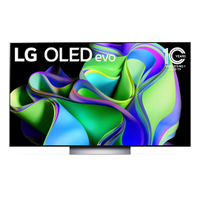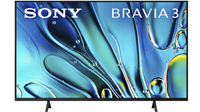Best 43-inch TVs in 2024: Expert tested and rated
The best 43-inch TVs for small living rooms, bedrooms and dorms
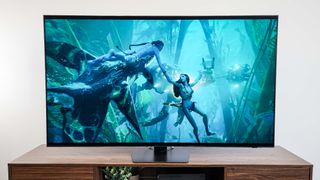
The best 43-inch TVs might be small and secure a much lighter screen real estate, but they offer you far more leeway in terms of room décor and space. You might even want to leverage one of the best 43-inch TVs as PC monitor.
I've been testing and reviewing TVs for years, so I'm well-equipped to help people shop for the best 43-inch TV across all price points. The best 43-inch TVs look good across all content types and offer useful features for gaming and beyond.
At the very top of this list is the LG C4 OLED, a 42-inch TV. Despite being an OLED TV, the LG C4 is on sale right now for far less than it was priced when it debuted. It offers an incredible picture (especially for 4K, HDR movies and shows) and comes with a lengthy list of gaming- and A/V-related features.
That said, the LG C4 still might prove a little expensive for most, or might not be a good fit for everyone's living space. We've tried to find something for everyone.
Recent updates
November 4, 2024
The 42-inch LG C4 OLED has replaced its predecessor, the 43-inch LG C3, as the best TV in the 42- to 43-inch size range. The Bravia 3 has been added to this guide, too, and we are currently evaluating the 43-inch Samsung Q60D, the 43-inch Samsung DU8000, and the 43-inch Samsung DU7200.
Best 43-inch TV
The best 43-inch TVs in 2024
Why you can trust Tom's Guide
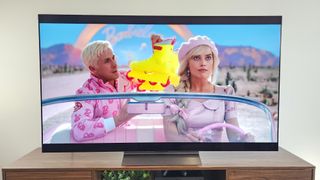

Specifications
Reasons to buy
Reasons to avoid
The best 43-inch TV you can buy right now is the 42-inch LG C4 OLED. It's replacing last year's LG C3 OLED in the top spot. If you're looking for a smaller-sized TV that doesn't cut corners, the C4 is the way to go.
You'll pay more for the 42-inch C4 than most TVs in this size range (and lose out on a single inch), but I think it's worth it. Like all OLED TVs, contrast is the C4's bread and butter. Its self-lit pixels allow for perfect black levels and precise contrast control. There are other benefits to the display tech, too: wide, accommodating viewing angles and an ultra-thin, featherlight design. Its svelte build makes it an especially attractive option for narrow desks (or otherwise limited tabletop space).
The C4 is a gaming powerhouse. All four of its primary inputs are HDMI 2.1 and support 4K gaming at both 120Hz and 144Hz. That last spec makes the C4 a terrific option for folks who want to use it as a monitor for PC gaming. The LG C4 also supports ALLM, VRR, FreeSync Premium, and offers G-Sync compatibility. Crucially, we clocked its input lag below 10ms, too, making it a fine companion for competitive gamers who can't afford to lose a step.
It's a wonderful way to showcase HDR movies, shows, and games, but ultimately, the 42-inch C4's current price is what propels it to the top of this list. At the time of this update, it's on sale for about $900 — more than most 42- to 43-inch TVs, but I'm quite confident that you'll find it worthy.
Read our full LG C4 OLED review.
Best QLED TV

Specifications
Reasons to buy
Reasons to avoid
The Samsung QN90D is our pick for the best QLED TV in this small size range. It's replacing last year's excellent QN90C model. Like its predecessor, the QN90D comes in a perfectly compact 43-inch screen size and offers a higher peak brightness than many of its peers.
In our tests, the Samsung QN90D reached a peak brightness of 2,091 bits in a 10% window — a huge improvement over the QN90C. I was also quite impressed by the QN90D's local dimming, which kept all of that brightness in check and minimized light bloom when bright objects met surrounding darkness.
The 43-inch Samsung QN90D is a bright alternative to the 42-inch LG C4 OLED. If the room you're planning on putting your next TV in gets a high amount of sunlight, I recommend the QN90D over the C4. The QN90D's suite of hardware- and software-related gaming features is comparable to the C4's, and right now, these two TVs are priced similarly.
Read our full Samsung QN90D Neo QLED TV review.
Best value TV
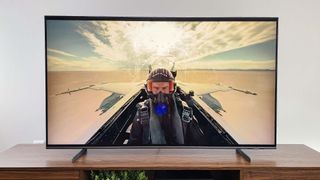
Specifications
Reasons to buy
Reasons to avoid
Our pick for the best value 43-inch TV is the 43-inch Samsung Q60C. Compared to a higher-end Samsung QLED (like the 43-inch QN90D), the Q60C drops some features and takes a hit on performance, but the result is that you're getting a QLED TV at a steep discount. Its low brightness means movies and shows (especially those mastered in HDR) won't look as punchy as it will on other sets, but if all you need is a decent-looking, 43-inch 4K TV, the Q60C is a great, value-forward pick.
It's not a gaming machine like the Samsung QN90D, but the Q60C is still a good choice for gamers on a budget, as it comes with impressively low input lag and strong color accuracy. Games will look good and play smoothly, even though 4K games will max out at 60fps.
The Q60C also comes with a built-in smart platform that will cover all of your streaming needs, should you opt not to use a dedicated streaming device. If you need something more affordable for a second room, the Samsung Q60C covers the basics for a reasonable price.
Read our full Samsung Q60C QLED review.
Best budget TV
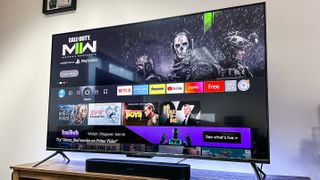
Specifications
Reasons to buy
Reasons to avoid
The Amazon Fire TV Omni won't win any awards for earth-shattering HDR performance, but its built-in Fire TV platform and low sticker price make it a suitable option for folks looking to spend as little as possible on a 43-inch TV without scraping the bottom of the barrel.
As mentioned, the 43-inch Fire TV Omni doesn't showcase 4K, HDR content in a way that truly takes advantage of the format. Still, for a TV in this price range, it'll pass most people's eye test.
The ability to summon Alexa hands-free is great when you want to ask a quick question, and its respectable 10ms of input latency make it one of the better picks for gamers looking to spend less than $400 on a 43-inch gaming TV.
Amazon's smart TV software has always been at its best when showcasing built-in Alexa functionality, but the Amazon Fire TV Omni series takes this to a new level, enhancing that capability and pairing it with a better looking TV than any Fire TV we've seen before. It's not a perfect product, but our Amazon Fire TV Omni review explores the many ways Amazon tries to make its new Fire TV the best Fire TV.
Read our full Amazon Fire TV Omni review.
Best 43-inch TV test results
| TV | Peak Brightness (tested) | Delta-E (tested) | BT2020 Color Volume (tested) | Input Lag (tested) |
| LG C4 OLED | 1,049 nits | 1.8 | 72.27% | 9.2ms |
| Samsung QN90D | 2,024 nits | 2.6 | 72.52% | 9.6ms |
| Samsung Q60C | 410 nits | 1.6 | 69.79% | 9.0ms |
| Amazon Fire TV Omni | 556 nits | 1.9 | 73.8% | 10ms |
| Sony Bravia 3 | 448 nits | 3.5 | 69.81% | 9.2ms |
Other 43-inch TVs we've tested
Of course, these aren't the only 43-inch TVs aren't the only ones we've tested. Here are other 42- and 43-inch models that didn't make our top list.
LG 42" C3 OLED TV: It may be well over a year old at this point, but the 42-inch LG C3 OLED is almost as impressive as its successor, the LG C4. You're getting a full slate of gaming features (including four HDMI 2.1 inputs and support for 4K gaming at 120Hz), plus several years of software updates to LG's webOS smart platform.
Read our full LG C3 OLED review.
Sony 43" Bravia 3 LED TV: The most affordable TV that carries the Bravia moniker is Sony's Bravia 3, and right now, the 43-inch Bravia 3 is on sale for around $499. Despite the Bravia 3's lack of luminance and local dimming, I appreciated the accuracy of its out-of-the-box performance in Sony's Professional picture mode. It's priced higher than most budget-oriented 43-inch TVs, however, so you'll have to spend a bit more for Sony engineering.
Read our full Sony Bravia 3 review.
How to choose the best 43-inch TV
How to choose the best 43-inch TV for you
When looking for a 43-inch TV, follow our TV Buying Guide tips. If you put some thought into what you need from a TV, you’ll be able to enjoy your purchase for years to come.
First, check that a 43-inch TV makes sense for your space. According to our What size TV should you buy? guide, a 43-inch TV is ideal for viewers seated 3.5 to 4 feet away from the screen. That size makes them the perfect second TV for a bedroom, an inexpensive kids TV or a dedicated TV for gaming.
If your space will allow for a larger unit, we recommend you go bigger — even if you think you’ll be happy with a smaller screen, a bigger one helps make the experience of watching more engaging.
Finally, consider which ports you need and how many. The number of HDMI ports you need depends on how many devices you plan to plug in — a streaming stick, game console or cable box, for example. Most of these TVs have three HDMI inputs, but some have four. If you plan to use a sound bar, you may need an optical digital audio or a 3.5 mm auxiliary output. You may also want a TV that supports Bluetooth so you can listen on your headphones without disturbing people around you.
If you've narrowed down your TV shopping by brand, price range or screen size, check out our picks for the best TVs in each.
Best TVs | Best 4K TVs | Best smart TVs for streaming | Best TVs for gaming
The best TVs under $1000 | The best TVs under $500
Best TV brands | Best Samsung TVs | Best TCL TVs | Best LG TVs | Best Roku TVs | Best OLED TVs | Best QLED TVs | Best 8K TVs
The smallest smart TVs | Best 50-inch TVs | Best 55-inch TVs | Best 65-inch TVs | Best 70-inch TVs | Best 75-inch TVs | Best 85-inch TVs
And don't forget to watch out for the latest TV reviews.
How we test 43-inch TVs
How we test 43-inch TVs
When it comes to evaluating the best 43-inch TVs, we're serious about getting it right. That's why every TV we review is put through a rigorous testing process that measures key standards of picture quality and performance.
Our lab tests involve testing for color accuracy and color gamut using an X-Rite i1 Pro spectrophotometer, an AccuPel DVG-5000 video test pattern generator and SpectraCal CalMAN Ultimate calibration software. These tools are relied on by professional calibrators throughout the industry, and we've paired them with custom workflows to gather the information needed for our reviews. These measurements are taken first in standard mode to simulate the average watching experience, and then taken again in other display modes to find the top color and brightness performance offered by each set.
Our testing measures contrast and maximum brightness, as well as lag time. Using a Leo Bodnar Video Signal Input Lag Tester to test video signal delay, we time how long it takes for content to travel from the original video source to the screen, measured to the millisecond. Shorter response times equate with faster gaming performance, letting us objectively know which TVs are better for gaming.
We use all of these objective test results to make comparisons about quality and performance between different TVs, but our evaluation doesn't end there. We also spend hours with each set, watching shows and movies, and using carefully selected video samples to highlight the strengths and weaknesses of each set and help us tell you which TVs look and sound the best in a real home viewing environment.
And there's more to today's TVs than just viewing, so we also check out the smart TV functions and evaluate everything from the interface to the remote control design. This lets our reviews speak to the technical capabilities of today's smart TVs and how they fit into your connected home.
- Questions answered: What size TV do I need?
- The best soundbars for your TV
Sign up now to get the best Black Friday deals!
Discover the hottest deals, best product picks and the latest tech news from our experts at Tom’s Guide.

Nick Pino heads up the TV and AV verticals at Tom's Guide and covers everything from OLED TVs to the latest wireless headphones. He was formerly the Senior Editor, TV and AV at TechRadar (Tom's Guide's sister site) and has previously written for GamesRadar, Official Xbox Magazine, PC Gamer and other outlets over the last decade. Not sure which TV you should buy? Drop him an email or tweet him on Twitter and he can help you out.
- Michael DesjardinSenior Editor, TV
